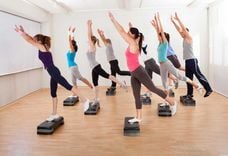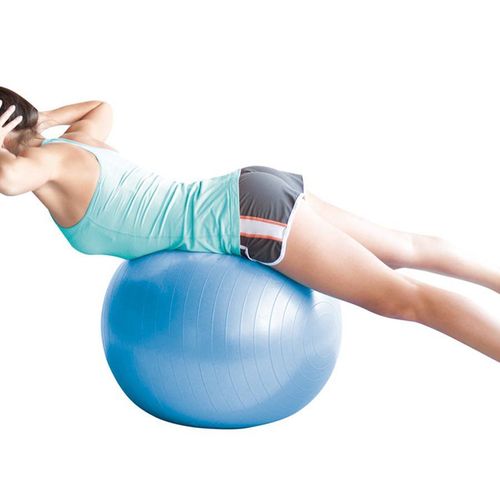This is an automatically translated article.
1. What is strength training?
Strength exercises are physical exercises that train endurance or muscles by using assistive devices or the practitioner himself. When performing, the practitioner moves the body to resist some resistance such as: body weight, dumbbells, resistance bands, resistance machines,... This exercise helps to increase lean muscle mass, very Important for weight loss because lean muscle burns more calories than other tissues.
Besides, when we lose weight, we can lose muscle, so we need to exercise to retain that muscle mass. And high-intensity exercises are the ideal choice. In addition, as we age, the body also tends to lose muscle mass naturally. Therefore, training in strength and endurance exercises is very important for older people.
Strength exercises include: Lifting weights, using resistance bands, using your own body weight (push-ups, sit-ups, leg curls, push-ups against the wall,...), using weight machines This is a versatile form of exercise that you can do anywhere, be it at the gym or at home.
2. Benefits of Strength Training
Hard work following strength training programs, endurance brings many benefits to practitioners such as:
Increase lean muscle mass or prevent muscle loss; Increase bone density, increase bone strength and reduce the risk of osteoporosis; Boost metabolism, help with weight loss and weight maintenance; Increase muscle strength, help practitioners easily perform daily activities; Reducing the risk of injury through strength and flexibility of muscles and joints; Improve brain health and enhance cognitive function; Reduce blood sugar, improve sensitivity to insulin hormone, make blood sugar level more stable; Reduce symptoms of many chronic diseases such as back pain, diabetes, arthritis and cardiovascular disease; Improves body posture and brings a more upbeat, joyful mood.

Nâng tạ là bài tập tăng thể lực phổ biến
3. How often do strength exercises?
Experts recommend that each person do strength training exercises at least 2 days a week. These exercises will work all major muscle groups in the body such as legs, hips, back, chest, abdomen, shoulders and arms.
For each muscle group you work out, you should do at least 8-12 reps (like lifting weights). To get the most benefit from exercise, you need to work your muscles to the point where it's hard to do any more. However, practitioners also note that they should not train the same muscle group on 2 consecutive days because the muscles need time to recover.
4. Measures to avoid injury when exercising to increase fitness
When following strength and endurance exercises, you need to have the correct posture. If you do some exercises with poor technique, you may get injured. As such, it is best to practice with a professional trainer or follow the online tutorials to be able to practice the right technique.
Beginners to strength training exercises should start with light weights that they can lift or push at least 8 times themselves. When lifting weights has become easier, you can add more weight. According to experts, once you feel comfortable lifting a certain weight, you can increase the weight by about 2 - 10%, then continue to lift heavier weights until you feel comfortable.
5. Fitness training process at home
5.1 Benefits of working out at home
Building a habit of exercising at home brings many benefits to practitioners such as:
Save time because you don't have to go to the gym, wait for others to finish practicing machines and equipment; Cost savings because there is no need to buy exercise cards or expensive equipment; You can practice at any time according to your schedule; Ensure maximum privacy when exercising; Practice at your own pace, with no pressure to keep up with those around you.

Khởi động trước khi thực hiện bài tập tăng thể lực
5.2 Some strength exercises suitable to do at home
Prepare
When you are ready to work out to improve your fitness, first you need to find a space in your home where you can exercise comfortably. That space should have enough room for you to freely move your arms, legs, body,... Besides, you need to invest in some supporting tools such as: Exercise mats, resistance bands, dumbbells, dumbbells kettle, exercise ball,... And if you want to save more money, you can replace using weights with water bottles, sandbags,...
If you are new to strength and endurance training, You can learn from online beginner workout programs. This allows you to correctly warm up, perform a variety of exercises, and cool down after a workout.
Warm-up
Before starting a workout, you should warm up for 5 - 10 minutes. Forms of warm-up include: Brisk walking, jogging in place or movements that move arms, legs or other major muscle groups on the body.
Workout
Once you have warmed up your muscles and are ready to move, you can do a series of exercises below.
Bodyweight exercises: Lunge, overhead squat, plank, push-ups; Free weight exercises: Lifting weights overhead, training triceps with dumbbells; Exercises with resistance bands: Includes exercises for arms and legs with resistance bands. Cool down
At the end of the workout, you should cool down for about 5-10 minutes. This allows the breathing and heart rate to shift to a resting state. You can cool down by walking in place and doing gentle stretches.
You can do 30 - 45 minute strength exercises about 2-3 times a week to build muscle mass, burn calories and boost metabolism. That helps burn fat better, weight loss easier. At the same time, strength training also helps strengthen bones and joints, improves flexibility of the body, reduces the risk of chronic diseases,... If you are worried about your health or risk In case of injury when exercising, you can talk to your doctor or trainer before exercising at home.
Please dial HOTLINE for more information or register for an appointment HERE. Download MyVinmec app to make appointments faster and to manage your bookings easily.
References: healthline.com, livescience.com













